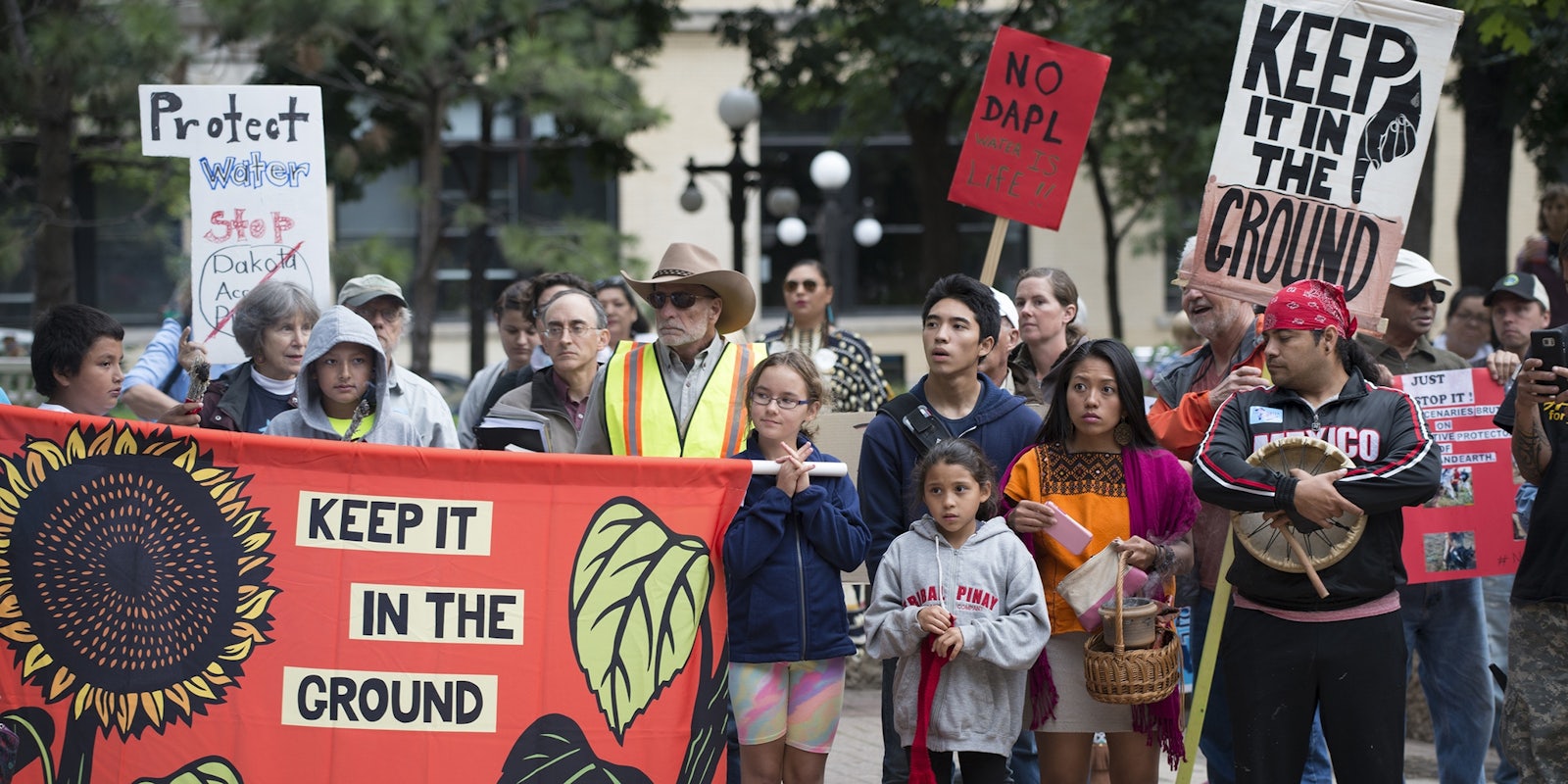For the past six months, the Standing Rock Sioux have gone toe-to-toe with Energy Transfer Partners, the Texas-based corporation behind the Dakota Access Pipeline.
The project, if completed, is intended to carry roughly 470,000 barrels of crude per day from the Bakken oil fields of North Dakota to a terminal in Illinois more than 1,130 miles away. At the heart of the dispute, the pipeline is set to cross beneath the Missouri River at Lake Oahe, the primary source of drinking water for those living on Sioux land, which straddles the border between the Dakotas.
“We must stand with the local leaders and communities who are holding the line against this dirty and dangerous oil pipeline.”
The Standing Rock Sioux Reservation was once part of the Great Sioux Reservation, which was established under the Treaty of Fort Laramie. Signed in 1868, the treaty also includes lands that were later seized illegally by the U.S. government, including the Black Hills. Lake Oahe is near two burial site monuments memorializing Sitting Bull, a famous Hunkpapa Lakota leader of the Great Sioux War, which erupted as a direct result of the government’s treaty violation.
Support for the Standing Rock Sioux has been widespread on social media. Thousands of Facebook users this week began to digitally check-in at the protest site, where police and protesters have clashed for several months. The outpouring was prompted by rumors that checking in on Facebook would confuse police accused of monitoring activists using social media surveillance tools. The Morton County Sheriff’s Department on Monday denied collecting any data from protesters checking in on Facebook. (The primary source of locational data for many police departments is actually Twitter and Instagram, though both of the networks severed access to top surveillance firms last month.)
Join the protest
Protest leaders have since pointed to a variety of other ways in which Americans can support their cause. Chiefly among them, activists at Standing Rock say their cause would benefit most by the arrival of more protesters at the site.
-
Fill out this form from the Sacred Stone Camp website if you’re interested in joining the protest. Take note: Joining the protest may land you in legal trouble—more than 140 people have been arrested so far.
Call elected officials
For those of you unable to make such a journey but desire to participate on some level, you can start by lobbying the elected officials most likely to be affected by the outcome of the Dakota Access battle.
-
To contact North Dakota Gov. Jack Dalrymple about the Dakota Access Pipeline, call: 701-328-2200. You can also submit letters to the governor through his office’s online submission form. Last month, the Daily Dot published dozens of letters received by the governor’s office criticizing use of force against the demonstrators.
Donate to the protester camp
Sacred Stone Camp is crowdfunding to feed and shelter the demonstrators. “We are asking for financial support for water, propane, food, and blankets for the camp,” the group writes. “This is a prayer camp movement to save our sacred land and water and has been entirely supported by the people and the campers.”
-
Standing Rock Sioux Tribe have thus far raised over $1.26 million. You can chip in, too, at GoFundMe.
Sign a petition (or two)
More than 341,000 people have signed a White House petition demanding it take action to halt the Dakota Access Pipeline. The petition cites the risk the pipeline poses to the reservation’s water supply, noting an accident this summer that leaked more than 20,000 gallons of oil down a North Dakota hillside. The White House petition has already reached its goal, but supporters can still attach their names as a show of solidarity.
Credo Action, a social activist network, has a separate petition calling on the president to take action. It currently has more than 343,000 signatures. The petition claims the U.S. Army Corps of Engineers’ approval of the Dakota Access Pipeline conflicts with “numerous federal laws and agreements,” including the Clean Water Act, the National Environmental Policy Act, as well as the Native American Graves Protection and Repatriation Act. “We must stand with the local leaders and communities who are holding the line against this dirty and dangerous oil pipeline,” the petition reads.
Throw a protest party
Greenpeace is encouraging people to host house parties in support of the #NoDAPL movement for the purpose of spreading awareness and raising funds for protesters on the ground. The group has put together a guide to help those interested in hosting their own event get things started. (The donation link provided by Greenpeace is broken, so consider donating to the Sacred Stone Camp’s legal defense fund instead.)
Share the message
Last but not least, the Sacred Stone Camp has also launched a website called #NoDAPL Solidarity to support the indigenous-led movement. Instructions offered by the site will aid those interested in participating in nonviolent direct action; users can join the Global Solidarity campaign; and it also provides numerous outreach materials that can be shared through social media.


